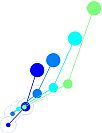Both humans and monkeys are skillful at learning to form representations of latent states of their environments, those that must be inferred from observations. The neural circuits that govern this sophisticated skill include the orbitofrontal cortex, hippocampus, amygdala and other regions. Whether these regions merely store representations of latent states or actively construct them remains to be described. Further, if they are constructed, the mechanism for forming them is unknown. Here, we report on monkeys playing a simplified version of the game battleship, designed to investigate learning these latent states, while neural recordings were performed in orbitofrontal cortex. Monkeys visually uncovered one shape per trial over multiple choices. Monkeys were adept learners, as assessed against the optimal choice that maximizes expected reward. Analysis of orbitofrontal neurons suggest a role in learning environmental states. One third of neurons signal the entropy over the distribution of possible states, which dropped during learning as monkeys gathered evidence to rule in or rule out shapes. In addition, the fraction of neurons that represented locations of parts of shapes doubled during learning. Finally, the dimensionality of the population decreased during learning. Our results suggest that the orbitofrontal cortex forms representations of latent states during learning by recruiting neurons into coalitions that increases their covariation and consequently decreases the population dimensionality. Uncovering this role for orbitofrontal cortex extends previous studies by describing how latent state representations are refined over time as evidence is gathered from the environment. Finding evidence for the formation of neural coalitions underlying these representations suggests one mechanism by which representations of latent states are formed.
- Poster

 PDF version
PDF version

